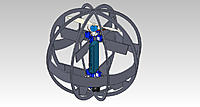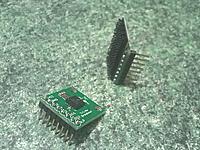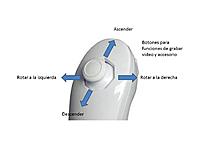|
|
|
|
|
Discussion
Dronopter (dronoptero)
Hi there? Greetings to all entrepreneurs in the RC comunity.
Here I stand with my first post about my new project. This is a flying sphere inspired by a famous Japanese design. Fare case of sharing the progress from this point as I have some time to work on this so I will share from the latest advances. Thanks for the comments and contributions they may provide. |
|
|
|
|
|
|
|
|
|
|
Your sphere looks great, can you post a few more photos, or some art work for us look over before your flight test?
May I recommend that you hang the craft from a clothes line, (horizontal string) with a bunch of slack in the line during the first several flights. This will allow you to get the P an I terms set and also adjust the required off-set in the vanes to counter the motor torque in a steady hover without fear of damaging you very nice workmanship. Good luck on your testing Kelly |
|
|
|
|
|
|
|
|
The main control system on board is a MCU programmed with a PID software of my creation, to do the stabilizations at same time that is contrled for the ground station.
The PID works in 3 axes, vertical, frontal and lateral. One more component is present like a little torque by the rotation or the propeler. This most be compensated by the controller too. For all this, the control surfaces make complex mixes to do the vectored thrust. In general, this controller is not existing comercially be cause the people only needs a single controls for airplanes or helicopters that is only needed single movements. In this case we need complex mixers to control the air in totally movable in any directions to control the aircraft. |
|
|
|
|
|
|
|
|
Victor,
How about an update? Any luck? Kelly |
|
|
|
|
|
|
|
|
Hi to all.....
I had some problems with my lipo charger so I have not been able to test elevation but I did functionallity test of all mechanical elements. I will put some videos of this and some pictures of advances and other elements on which I am working |
|
|
|
|
|
|
|
|
Hello Victor,
This all looks very interesting and exciting. Can you please share with us how the nunchuck(s) interact with your TX and what control is used to handle yaw motion. I can image how pitch and roll would work by tilting the wrist, is yaw controlled by a twisting motion of the wrist? How is power applied? Thanks for the feedback, Kelly |
|
|
|
|
|
|
|
|
Hello again Kelly, thanks for follow the post.
Ok, I can explain you little bit more about..... I think on a nunchuck like a control lever of plane. Any pilot can control the airplane moving the lever. In this way I want do the same with the nunchuck. This nunchuck have internally an acelerometer that can measur the movements and angle of inclination. With this as in transducer to control all the system. Onboard Dronopter have 2 sensor, one to sense the movement and other for the rotation. This 2 sensor are the realimentation of the system control. The nunchuck joystick control the vertical and horizontal displacements I manage the nunchuck with an MCU (PIC16) to read and process la informacion del nunchuck and send by RF with a little RF transmiter connected to the MCU. The information is received in the Dronopter and process in the MCU onboard. |
|
|
|
|
|
|
|
|
I agree.... The nunchuck is not the tricky part.... with a few programation is working as you want. The fun is programan 2 nunchuck in the same MCU, one to fly controls and other for the camera and functions on board.
For the magnetometer I may agree, is the common solucion in RC, and many commercial aplications have one, but as aplication to a tool for fly plan for airplane. In my case, inasmuch as this flayer is a sphere, for me works better 2 accelerometers be cause one is centered in the body of Dronopter to measure movements in all directions (to detect the steady state) vectoring the direction and dimention of movements. Other in a most external side of the sphere to detect any rotation in any direction. With this we get the capacity to land on ground and roll like a wheel to any direction totally controlled. the mix of both sensors works like a gyro. Both sensors together works like a flight instrumentation to "sphere flyer", to control all movements in air and ground. This Dronopter can ascend, descend, rotate, and moves (lateral, frontal) and roll in ground. All incluisive the airplanes movements (pitch, roll and yaw). |
|
|
|
|
|
|
|
|
The master part to do fly the dronopter is the MCU on board, apliying 3 PID controls, each one for one axe. This control is the most laborius wokr in the project. The programation for this element is really comples be cause implies to much mathematics.
This MCU controls the stability of flight, controling any movmente unwanted for perturbation of airstream or others situations. The principal axe is the vertical, this control the elevation. The other 2 axes controls the stability frontal and lateral. As you can understand, thatīs not all. To control this estabilizations the controller most move the control surfaces and motor power. For steady state requires move the ailerons slightly clockwise to give an angular force to compensate for inertial moment of the engine as you can see in the picture above. Added to this, to make a move to front side only need to move the corresponding pair of flaps, the controller must add this momiviento to the rotation, and compensate on vertical axe with motor power. As you can see, the controller (Master MCU onboard dronopter) not only has the PID control, but also is a complex mixer for all components. Variant mixers for each case. |
|
|
|
|
|
|
|
|
Hello everybody.....
The last weekend we made some test of elevation (takeoff) to test the ability to rise. Whe have first a little crash and then other more jejejeje. Here the pics, next to I'll put a video (actually on edition). |
|
|
|
|
|
|
|
|
Subscribed!!!!!
|
|
|
|
|
|
|
|
|
Victor
A suggestion: Hang the sphere from a slack clothes line. Look at "The Cube" thread, on the VTOL page , you'll see a video showing the concept. There is no need to risk a crash. You can also support it with four threads hanging from the back of 4 tall chairs with small amount of slack, just the amount required to see the related motion during testing. Look here for "The Cube" thread, using the clothes line idea: https://www.rcgroups.com/forums/show...1822850&page=4 Kelly |
|
|
Last edited by corocopter; Mar 23, 2013 at 02:16 PM.
Reason: Added hyperlink
|





























